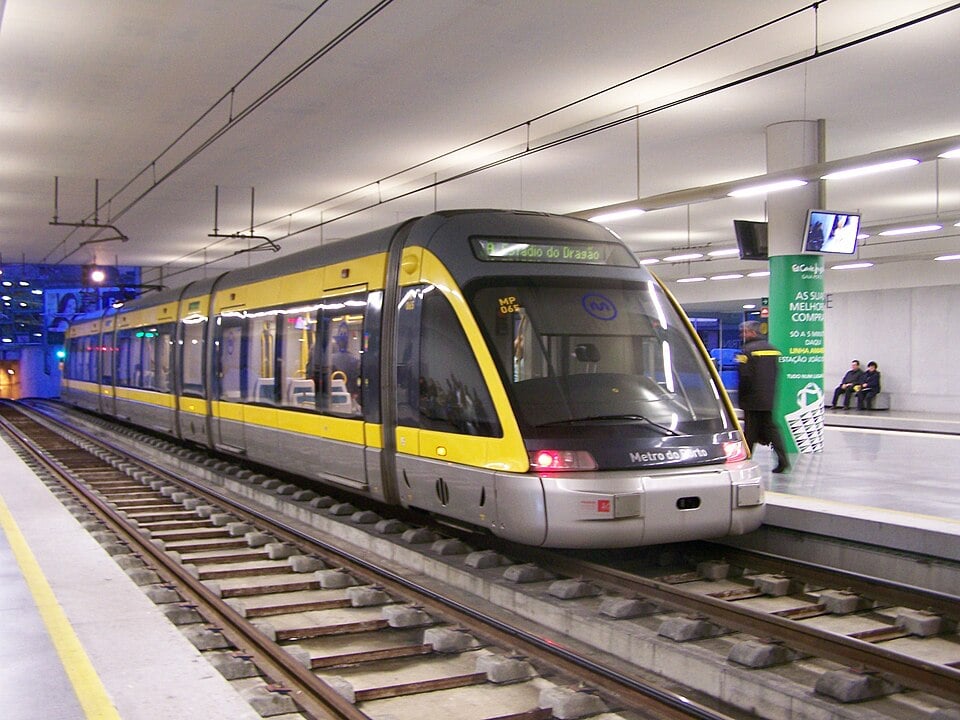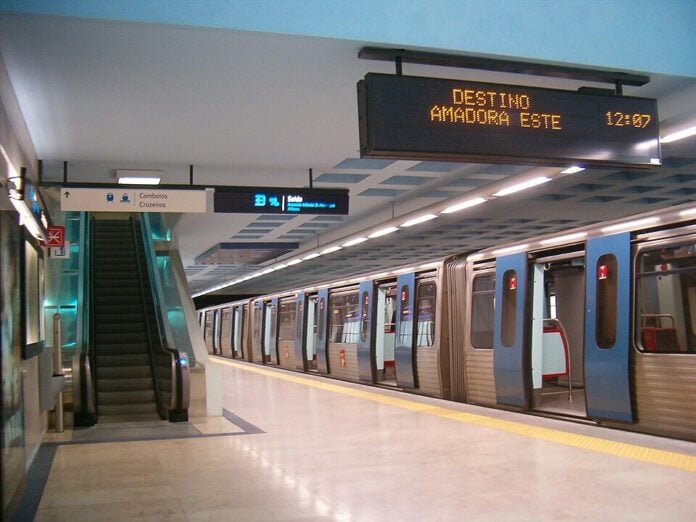If you’ve walked by a construction barrier in Lisbon or dodged scaffolding in Porto recently, you’re not alone. As a Lisbon resident passing by a metro construction site for the umpteenth time, I have often wondered: What exactly is going on with the Lisbon metro extension project or when will Avenida Liberdade look normal again? From subway tunnels snaking beneath city streets to massive rainwater drainage systems designed to withstand once-in-a-century storms, some sections of Portugal’s two largest cities resemble the epicenter of a construction site – and it seems like it is never going to end.
So what’s going on? Here’s a comprehensive update on the major infrastructure projects currently underway in Lisbon and Porto in 2025.
Lisbon Metro: Circular, Red, and Purple Line Extensions
The Circular Line (Rato to Cais do Sodré)
Originally projected to open in October 2024, the much-anticipated Circular Line has run into delays but is still mostly on track. The €331.4 million project will eventually connect Rato and Cais do Sodré, completing a full circle in the Lisbon Metro and introducing two new stations: Estrela and Santos. This connection is expected to radically simplify transfers for riders moving between the Green, Yellow, and Red lines.
However, due to construction delays and logistical setbacks, the opening is currently scheduled for Q2 of 2026, with commercial service expected shortly afterward. These will be the first new subway stations in Lisbon since April 2016 when the Blue Line was extended from Amadora Este to Reboleira.
Red Line Extension (São Sebastião to Alcântara)
While Lisbon Metro authorities awarded a €321.9 million contract for the Red Line extension in late 2023, the project has not yet broken any ground! Delayed first by legal disputes and now stuck in an administrative holding pattern, this project remains mired in paperwork. After receiving prior approval from the Court of Auditors in March last year, it still had to await the decision of a lawsuit filed by a competitor.
As of March 2025, the extension of this line with the construction of four new stations in Campolide/Amoreiras, Campo de Ourique, Infante Santo, and Alcântara is still awaiting the Decision on the Environmental Compliance of the Implementation Project (DCAPE) and a favorable opinion from the National Association for Emergency and Civil Protection (ANEPC) on the safety plan.
Once launched, this extension of the Red Line will bring the western half of Lisbon much-needed east-west connectivity. The project has strong financial backing, including €357.5 million from the Recovery and Resilience Plan (PRR) and the remainder from the state budget. However, even with funds secured, it’s become a textbook case of how bureaucracy can slow down critical urban infrastructure. It will be interesting to see if the Red Line extension will be completed before the construction of the new Lisbon airport.
The Purple Line (Loures to Odivelas Light Rail)
Nicknamed the Purple Line, this light rail system between Loures and Odivelas was originally a PRR-financed project, but it hit a wall when no contractors submitted affordable bids during the 2024 tender.
A new procurement process is now nearly finalized, with an estimated build time of 38 months (based on the Circular and Red line delays, add at least 36 more months to this). Financing is being restructured, possibly pulling from the State Budget, Environmental Fund, or EU Cohesion Funds designated for the 2030 cycle. If successful, this project could ease commuting congestion in some of the most densely populated suburbs of northern Lisbon, areas that have long been underserved by rail.
Lisbon’s Flood Defense General Drainage Plan
While the Lisbon Metro slowly inches its way forward, Lisbon’s General Drainage Plan (PGDL) is making substantial underground progress. On July 22, the massive tunneling machine known affectionately as “Oli” completed excavation of the city’s largest-ever drainage tunnel: 4.4 kilometers long, 5.5 meters wide, and buried up to 40 meters deep beneath the capital.
The tunnel stretches from Campolide to Santa Apolónia and passes below some of the most historic and flood-prone areas in Lisbon. Designed to handle even once-in-a-century rainfall events, it will prevent water from reaching vulnerable low-lying areas like Baixa, Avenida da Liberdade, and Alcântara.
Three vortexes (swirling vertical chutes that manage the descent of stormwater) are being built along the route. Two (at Avenida da Liberdade and Almirante Reis) are complete, and the third (Santa Marta) is in progress.
This winter 2025, the tunnel should begin operation. Meanwhile, Oli will be dismantled, moved overnight through Lisbon’s streets, and reassembled in Beato to begin work on a second tunnel toward Chelas in early 2026. This second tunnel will be smaller but no less important in managing Lisbon’s water control in the future.
There is, however, a cost: between September 2025 and April 2026, a crucial section of the Metro Blue Line between Terreiro do Paço and Santa Apolónia will close temporarily to allow safe reinforcement work where the new drainage tunnel crosses the existing subway line.
Porto Metro
Yellow Line Extension (To Vila d’Este)
Porto residents celebrated a long-awaited moment in June 2024 when the extended Yellow Line to Vila d’Este began full operations. Originally slated for a 2023 opening, the project faced delays due to the pandemic, supply chain disruptions, and inflation. Now complete, it offers southern suburban commuters easier access to central Porto and improves connections to major hospitals in Vila Nova de Gaia.
It’s also given new life to older stations along the line, which have been modernized to accommodate the increased number of riders.
Pink Line (Casa da Música to São Bento)
The Pink Line is moving forward albeit slowly. Stretching from Casa da Música to São Bento, it is now expected to be completed by July 2026. This line will help alleviate pressure on Porto’s most central metro hubs and allow for quicker east-west travel without requiring transfers. The final tunnel of the Pink Line project between Casa da Música and Galiza opened in August 2025 with this portion of the project currently expected to open in March-April 2026.
Costs for the Pink and Yellow lines have risen to €511 million, which reflects both their technical complexity and the rising cost of construction materials. Even so, city planners say the investment is crucial to meeting Porto’s 2030 mobility targets.
Rubi Line (Casa da Música to Santo Ovídeo)
The Rubi Line, awarded in late 2023 and funded by the PRR, is shaping up to be Porto’s next big step forward. The line will stretch from Casa da Música to Santo Ovídeo and feature a brand-new metro bridge over the Douro River. Construction is now underway, and the project is on track for a Q1 2027 completion.
When finished, it will serve daily commuters and ease traffic along the congested Luís I and Arrábida bridges.

Infrastructure in Context
It’s easy to reduce infrastructure projects to numbers and dates: euros invested, kilometers dug, and months delayed. However, behind every tunnel boring machine and legal document are real people waiting for better lives: a grandmother in Loures who struggles with overcrowded buses, a nurse in Gaia who walks 30 minutes from the closest metro stop, or a café owner in Alcântara who fears the next big flood could destroy her shop.
These projects, as frustratingly slow as they may be, represent Portugal’s attempt to catch up with the needs of a modern, growing population. Lisbon and Porto are increasingly global cities with tech hubs, digital nomads, booming tourism booms, new immigrant communities putting pressure on aging systems.
Until recently, both cities relied on infrastructure designed for a very different era. The Lisbon Metro’s core lines were built in the 1950s and 60s, when the population was smaller, denser, and less mobile. Porto’s initial metro system didn’t even launch until the early 2000s. In addition, climate resilience, which was once a niche concept, is now central to every urban project moving forward, especially as southern Europe faces longer droughts and more intense rainfall.
The tunnels, trains, and drainage systems underway represent a deeper urban shift towards building cities that must work for everyone, not just those who can afford a car or live on higher ground. Cities must focus on resilience and also dignity: the dignity of a reliable commute, the dignity of dry feet during a winter storm, and the knowledge that your city is investing in your quality of life, even if you can’t see it being built.
What You Can Expect Next
In Lisbon, the end of 2025 and beginning of 2026 will bring more disruptions. Expect announcements from the Lisbon Metro regarding the Blue Line closure, which will require careful planning for commuters along the Santa Apolónia–Terreiro do Paço corridor. Simultaneously, Beato will become the unlikely epicenter of Lisbon’s flood prevention strategy, as Oli the tunneler prepares to begin her second act underground.
In Porto, you’ll see the Rubi Line finally take shape, particularly along the Douro River where bridge construction will soon begin. This may involve visible changes to the waterfront including temporary closures, rerouted traffic, and a great deal of curiosity from locals and tourists. By mid-2026, the Pink Line should be nearing completion, and São Bento will become an even more crucial interchange station.
Final Thoughts
Progress takes time, and in Portugal, we know that it often takes longer than anyone expects. The good news is: it is happening.
So the next time you’re stuck waiting for a delayed metro or rerouted down a side street filled with orange cones, remember: that’s the sound of the future arriving. It’s just not here yet.
But the future is always on its way. Soon enough, Lisbon and Porto won’t just be two beautiful cities. They’ll be better ones.



Bom dia Becky! Obrigado for an excellent article. I’ve retired to Lisbon from the SF Bay Area of California. I just found this via a web search and subscribed. Almost three months old now but given the timelines for these massive projects still very relevant. The report was comprehensive yet efficient and clear in all of the information.
I think many readers would also find very useful a similar update of the existing Lisbon airport improvements to capacity before the new airport is opened, the state of construction for the new airport, the state of construction on the missing link of high speed rail from Lisbon to the Spanish border, and other improvements to north-south Portuguese rail service. Also when the Spanish side will have service from the border to Madrid, etc ready to go.
I have some wagers with my friends back in California if Portugal’s high speed service from Lisbon through to Madrid will open for passenger service before California’s twenty year project to have the initial high speed rail service between two cities in the middle of the California Central Valley. Thanks! Ken
Hi Ken,
Thank you very much for your kind words and great idea for an article about rail links and updates on the Lisbon airport improvements. That’s an interesting wager regarding California vs. Portugal. My guess might be that California gets it done first because it is only dealing with one state and not issues between two countries.
Thanks,
Becky